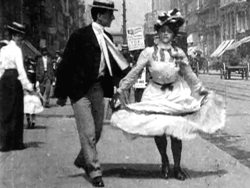Description
WARNING: This work contains throbbing light. Should not be viewed by individuals with epilepsy or seizure disorders.
Jacobs applies three-dimensional digital animation to a century-old film by Edwin S. Porter, the pioneering motion picture director for Thomas Edison's production company. Porter's 1901 movie What Happened on 23rd Street was advertised in the Edison Catalog as "a winner and sure to please," offering a glimpse of a "young lady's skirts suddenly raised to an almost unreasonable height, greatly to her horror and much to the amusement of the newsboys, bootblacks, and passersby." In his revision, Jacobs stretches the film to thirteen times its original length. The use of slow motion is a teasing promise to reveal more of the iconic skirt-billowing scene; however, the strobe effect, crucial to Jacobs' 3-D technique, obscures the action.Ken Jacobs writes, "It was a set-up. A couple walks towards the camera, a sidewalk air-vent pushes the woman's dress up. Layers of cloth billow and she is mortified. The moving-picture camera, already in place and grinding away, captures the event and her consternation becomes history, now transferred to digital and shown everywhere.
In this cine-reassessment, the action is simultaneously both sped up and slowed down. How can that be? Overall progression is prolonged, so that a minute of recorded life-action takes ten minutes now to pass onscreen. Slow-motion, yes? No. Instead, the street-action meets with a need to see more, and there descends upon the event a sudden storm of investigative technique in the form of rapid churning of film-frames, looping of the tiny time-intervals that make up events. Black intervals enter and Eternalisms come into play meaning that directional movements continue in their directions without moving, potentially forever (hence the eternal factor, something possible to cinema however inconceivable in real life). Further, the two-dimensional reality of the screen is contested. Are things now appearing in depth? Flat they are not. Can there be a 2 1/2 D?
The young woman steps past the air-vent and laughs."
Edwin S. Porter and Ken Jacobs, 2009. Assisted by Erik Nelson.
Exhibition & Distribution Conditions
WARNING: This work contains throbbing light. Should not be viewed by individuals with epilepsy or seizure disorders.
